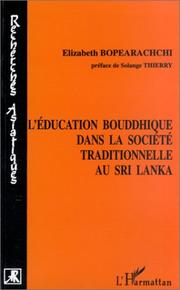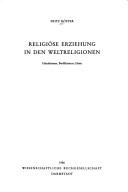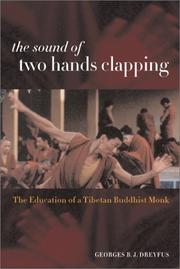| Listing 1 - 10 of 12 | << page >> |
Sort by
|

ISBN: 9782738427878 2738427871 Year: 1994 Publisher: Paris: L'Harmattan,
Abstract | Keywords | Export | Availability | Bookmark
 Loading...
Loading...Choose an application
- Reference Manager
- EndNote
- RefWorks (Direct export to RefWorks)
Book
ISBN: 9780824882389 0824882385 9780824889838 0824889835 0824883578 Year: 2020 Publisher: Honolulu University of Hawaiʻi Press
Abstract | Keywords | Export | Availability | Bookmark
 Loading...
Loading...Choose an application
- Reference Manager
- EndNote
- RefWorks (Direct export to RefWorks)
"The central objective of this book lies in discovering which part of their enormous canonical and non-canonical literature Korean Buddhist professionals choose to focus on as the required curriculum in their training, and what they elect to leave out. It asks why these texts are chosen, who does the choosing, and how the selected pedagogical programs shape and reflect the way monks and nuns comprehend their religion and their roles within it. It is essentially fashioned as a biography of a curriculum. It centers on the birth, institutionalization, fall, and replacement of the "traditional" Korean Buddhist monastic curriculum over the course of the past five centuries. It illustrates how a particular sixteenth- and seventeenth-century pedagogic program was reimagined in the course of the twentieth century to become the sole unified Korean monastic program, only to be criticized and utterly reformed in the twenty-first. Through a detailed analysis of such modifications, I attempt to demonstrate how Korean Buddhist reformers today tend to imitate the pedagogical practices and canonize the textual totems of the contemporary international discipline of Buddhist studies, and how, by doing so, they ultimately transform Korean Buddhist orthodoxy from a particular kind of Chinese-centered scholastic Chan, to the broad, inclusive, pluralistic, Indian-focused religion we usually find in our English-language introductory textbooks"
Book
ISBN: 9780199373093 0199373094 9780199373109 9780190629151 Year: 2017 Publisher: New York, NY Oxford University Press
Abstract | Keywords | Export | Availability | Bookmark
 Loading...
Loading...Choose an application
- Reference Manager
- EndNote
- RefWorks (Direct export to RefWorks)
Book
ISBN: 9780824897574 9780824898878 Year: 2024 Publisher: Honolulu University of Hawaiʻi Press
Abstract | Keywords | Export | Availability | Bookmark
 Loading...
Loading...Choose an application
- Reference Manager
- EndNote
- RefWorks (Direct export to RefWorks)
"How have Buddhist teachings come to be in modern and contemporary Japan and how are they taught? This pioneering work seeks to answer these questions by highlighting the public teachings of Temple Buddhism institutions, in particular Temple Buddhism kindergartens and Buddhist secondary schools and colleges. The community outreach provided by these Buddhist facilities is far greater than any other with the possible exception of funerals yet until now it has received little attention from scholars of Japanese religion. After determining what is taught in Buddhist education and how, Stephen Covell introduces readers to a select group of monks who undergo some of the most grueling practices in Japanese Temple Buddhism to determine if the public-facing teachings of Buddhist education are unique or similar to those of elite Buddhist practitioners. The teachings and sites of teaching examined here include but are not limited to classical doctrinal studies and temples focused on the education of Buddhist clergy. Covell uncovers the arguments made by priests involved in morals education, the dharma talks of famous ascetics, and the ways in which laws and legal codes have changed Buddhist education. He looks at what is taught on the ground, online, and in popular texts to discuss the current teachings embraced as Buddhism within the institutions of Temple Buddhism. Among his numerous findings is such teachings and worldview are remarkably similar to those of New Religions and Buddhist lay movements as outlined by Japan religion scholars and government bodies in charge of education. The Teaching and Teachings of Temple Buddhism in Contemporary Japan will be welcomed by students and scholars in Japanese religious studies and early childhood and higher education as well as those interested in current Buddhist practice and teachings in general"--

ISBN: 3534024400 Year: 1986 Publisher: Darmstadt Wissenschaftliche Buchgesellschaft
Abstract | Keywords | Export | Availability | Bookmark
 Loading...
Loading...Choose an application
- Reference Manager
- EndNote
- RefWorks (Direct export to RefWorks)
Buddhist education --- Hindu religious education --- Islam religious education
Multi
ISBN: 9789462094161 9462094160 9462094152 9789462094154 9462094144 9789462094147 9789462094154 9789462094147 Year: 2013 Publisher: Rotterdam : SensePublishers : Imprint: SensePublishers,
Abstract | Keywords | Export | Availability | Bookmark
 Loading...
Loading...Choose an application
- Reference Manager
- EndNote
- RefWorks (Direct export to RefWorks)
TCSE-Smith, blurb (final 9 August 2013) There are 400 million Buddhists in the world. Buddhists in Australia make up 3% of the population. So why have Buddhists had so little to say about educating youth? And, can Buddhism survive in Australia without educating youth? Sue Smith in Buddhist Voices in School answers why Buddhists are reluctant to ‘go public’ on education, and how Buddhism has much to offer the critical area of enhancing the wellbeing of young people. Here she distinguishes spiritual education from religion. Using case studies of Buddhist classes in primary schools Smith shows how a community adapted Buddha-Dharma to fit with contemporary education. The book describes how Social and Emotional Learning, inquiry and experiential approaches to education fit well with the intentions of Buddhism. In these classes students learned to meditate and explored ethics through a lively selection of Jataka tales. Voices from a Buddhist community, state school teachers, parents and also students inform the narrative of this book. It is the students themselves that reveal over time how they have developed calm, focus, kindness, resilience and better ability to make choices through their participation. The author concludes that the principles and techniques used in this program make potent contributions to current pedagogy. This book will be of great value to educators, academics and all those who have interest in Buddhism and who care about how children are educated.
Teaching --- onderwijs --- intensieve zorgen --- boeddhisme --- Buddhist education of children. --- Buddhism --- Buddhism and education. --- Study and teaching. --- Education.
Book
ISBN: 9780824866488 Year: 2017 Publisher: Honolulu University of Hawaiʻi Press
Abstract | Keywords | Export | Availability | Bookmark
 Loading...
Loading...Choose an application
- Reference Manager
- EndNote
- RefWorks (Direct export to RefWorks)
Buddhist monks --- Buddhist education --- Monastic and religious life (Buddhism) --- Buddhism and politics --- Education --- Xishuangbanna Daizu Zizhizhou (China) --- Religion.
Multi
ISBN: 9780824866525 9780824866488 Year: 2017 Publisher: Honolulu, Hawaii University of Hawaii Press
Abstract | Keywords | Export | Availability | Bookmark
 Loading...
Loading...Choose an application
- Reference Manager
- EndNote
- RefWorks (Direct export to RefWorks)
Social sciences (general) --- Buddhist monks --- Buddhist education --- Monastic and religious life (Buddhism) --- Buddhism and politics --- Education --- Xishuangbanna Daizu Zizhizhou (China) --- Religion.

ISBN: 0520928245 1597349070 9780520928244 0585468818 9780585468815 0520232593 9780520232594 0520232607 9780520232600 9781597349079 Year: 2003 Publisher: Berkeley, Calif University of California Press
Abstract | Keywords | Export | Availability | Bookmark
 Loading...
Loading...Choose an application
- Reference Manager
- EndNote
- RefWorks (Direct export to RefWorks)
A unique insider's account of day-to-day life inside a Tibetan monastery, The Sound of Two Hands Clapping reveals to Western audiences the fascinating details of monastic education. Georges B. J. Dreyfus, the first Westerner to complete the famous Ge-luk curriculum and achieve the distinguished title of geshe, weaves together eloquent and moving autobiographical reflections with a historical overview of Tibetan Buddhism and insights into its teachings.
Buddhist education. --- Buddhist monks. --- Buddhist monks-- Education-- China-- Tibet. --- Monastic and religious life (Buddhism). --- Monastic and religious life (Buddhism) - China - Tibet. --- Buddhist monks --- Buddhist education --- Monastic and religious life (Buddhism) --- Buddhism --- Religion --- Philosophy & Religion --- Monastic and religious life (Lamaism) --- Buddhist monasticism and religious orders --- Religious life --- Buddhist religious education --- Religious education, Buddhist --- Religious education --- Education
Book
ISBN: 9462094144 9462094160 9462094152 Year: 2013 Publisher: Rotterdam : Sense Publishers,
Abstract | Keywords | Export | Availability | Bookmark
 Loading...
Loading...Choose an application
- Reference Manager
- EndNote
- RefWorks (Direct export to RefWorks)
TCSE-Smith, blurb (final 9 August 2013) There are 400 million Buddhists in the world. Buddhists in Australia make up 3% of the population. So why have Buddhists had so little to say about educating youth? And, can Buddhism survive in Australia without educating youth? Sue Smith in Buddhist Voices in School answers why Buddhists are reluctant to ‘go public’ on education, and how Buddhism has much to offer the critical area of enhancing the wellbeing of young people. Here she distinguishes spiritual education from religion. Using case studies of Buddhist classes in primary schools Smith shows how a community adapted Buddha-Dharma to fit with contemporary education. The book describes how Social and Emotional Learning, inquiry and experiential approaches to education fit well with the intentions of Buddhism. In these classes students learned to meditate and explored ethics through a lively selection of Jataka tales. Voices from a Buddhist community, state school teachers, parents and also students inform the narrative of this book. It is the students themselves that reveal over time how they have developed calm, focus, kindness, resilience and better ability to make choices through their participation. The author concludes that the principles and techniques used in this program make potent contributions to current pedagogy. This book will be of great value to educators, academics and all those who have interest in Buddhism and who care about how children are educated.
Buddhism and education -- Australia. --- Comparative religion. --- Religion. --- Buddhist education --- Buddhism and education --- Education --- Religion --- Philosophy & Religion --- Social Sciences --- Buddhism --- Education - General --- Buddhist education of children. --- Buddhism and education. --- Study and teaching. --- Education and Buddhism --- Religious education of children, Buddhist --- Education. --- Education, general. --- Children --- Education, Primitive --- Education of children --- Human resource development --- Instruction --- Pedagogy --- Schooling --- Students --- Youth --- Civilization --- Learning and scholarship --- Mental discipline --- Schools --- Teaching --- Training --- Buddhist religious education --- Religious education, Buddhist --- Religious education
| Listing 1 - 10 of 12 | << page >> |
Sort by
|

 Search
Search Feedback
Feedback About UniCat
About UniCat  Help
Help News
News